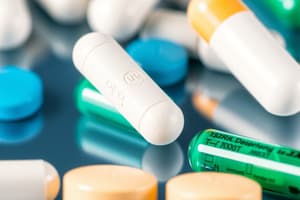Podcast
Questions and Answers
Which cellular process is directly inhibited by cytostatic drugs to achieve immunosuppression?
Which cellular process is directly inhibited by cytostatic drugs to achieve immunosuppression?
- DNA replication (correct)
- Protein synthesis
- Cellular respiration
- Lipid metabolism
What is the primary mechanism by which cyclosporin and tacrolimus exert their immunosuppressive effects?
What is the primary mechanism by which cyclosporin and tacrolimus exert their immunosuppressive effects?
- Blocking the interaction between interleukin-2 and its receptor
- Inhibiting DNA synthesis in lymphocytes
- Inhibiting calcineurin's activity, thus reducing interleukin-2 production (correct)
- Directly inducing apoptosis in T-cells
Which of the following is a key difference between the mechanisms of action of rapamycin and cyclosporin?
Which of the following is a key difference between the mechanisms of action of rapamycin and cyclosporin?
- Rapamycin directly inhibits T-cell proliferation, while cyclosporin only affects T-cell activation.
- Rapamycin inhibits interleukin-2 production by inhibiting the mTOR signaling pathway whereas cyclosporin inhibits calcineurin. (correct)
- Rapamycin is used for acute rejection, but cyclosporin is for chronic rejection.
- Rapamycin’s effects are primarily on B-cells, whereas cyclosporin targets T-cells.
Why might an anti-lymphocyte antibody like alemtuzumab be used in the treatment of multiple sclerosis?
Why might an anti-lymphocyte antibody like alemtuzumab be used in the treatment of multiple sclerosis?
How does Muromonab achieve immunosuppression?
How does Muromonab achieve immunosuppression?
Methotrexate is a cytostatic drug that inhibits dihydrofolate reductase, impacting which of the following processes most directly?
Methotrexate is a cytostatic drug that inhibits dihydrofolate reductase, impacting which of the following processes most directly?
What is the primary function of immunophilins in the context of immunosuppressant drug action?
What is the primary function of immunophilins in the context of immunosuppressant drug action?
In what scenario might the immunosuppressive adverse effects of a cancer chemotherapy drug be considered therapeutically beneficial?
In what scenario might the immunosuppressive adverse effects of a cancer chemotherapy drug be considered therapeutically beneficial?
A patient undergoing organ transplantation is prescribed both cyclosporine and glucocorticoids. What is the most likely reason for using these two immunosuppressants in conjunction?
A patient undergoing organ transplantation is prescribed both cyclosporine and glucocorticoids. What is the most likely reason for using these two immunosuppressants in conjunction?
A researcher is investigating a new drug that enhances the activity of regulatory T cells (Tregs). How would this drug likely be classified?
A researcher is investigating a new drug that enhances the activity of regulatory T cells (Tregs). How would this drug likely be classified?
Flashcards
Immunomodulating Drugs
Immunomodulating Drugs
Drugs that restore balance to a dysregulated immune system, divided into immunostimulants and immunosuppressants.
Immunostimulants
Immunostimulants
Medications that enhance specific functions of the immune system.
Immunosuppressants
Immunosuppressants
Medications that inhibit immune function.
Immunophilin Binding Drugs
Immunophilin Binding Drugs
Signup and view all the flashcards
Cytostatic Drugs
Cytostatic Drugs
Signup and view all the flashcards
Anti-lymphocyte Antibodies
Anti-lymphocyte Antibodies
Signup and view all the flashcards
Monoclonal Antibodies (immunosuppression)
Monoclonal Antibodies (immunosuppression)
Signup and view all the flashcards
Calcineurin
Calcineurin
Signup and view all the flashcards
Interleukin-2
Interleukin-2
Signup and view all the flashcards
Methotrexate
Methotrexate
Signup and view all the flashcards
Study Notes
- Immunomodulating drugs establish harmony during immune system dysregulation
- Immunomodulating drugs are divided into immunostimulants and immunosuppressants
- Immunostimulants enhance specific immune system functions
- Immunosuppressants inhibit immune function
Immunosuppressants
- Glucocorticoids are the most clinically relevant and researched immunosuppressants
- Other immunosuppressants are used with glucocorticoids in specific medical situations
- These situations include reducing organ transplant rejection risk and stent stabilization for blood vessel occlusion
- Non-glucocorticoid immunosuppressants are categorized into four main classes: immunophilin binding drugs, cytostatic drugs, antilymphocyte antibodies, and monoclonal antibodies
Immunophilin Binding Drugs
- Immunophilins are cytosolic proteins catalyzing cis-trans isomerization for the amino acid proline
- Correct protein folding relies on this isomerization
- Immunophilins act as the receptor for this class of immunosuppressants
- Cyclosporin and tacrolimus are examples of immunophilin binding drugs
- After administration, the drug enters the cytosol of T-cells and binds with immunophilin
- The drug-immunophilin complex binds to calcineurin
- Calcineurin acts as a transcription factor to promote interleukin-2 production
- The immunophilin-drug complex inhibits interleukin-2 transcription by binding to Calcineurin
- Interleukin-2 is a pro-immune chemokine which increases T-cell activity, maturation, and differentiation
- Reduction in interleukin-2 production leads to immunosuppression
- Rapamycin inhibits interleukin-2 production via inhibition of the mTOR signaling pathway, and it is another immunophilin binding drug
- Immunophilin binding drugs are primarily used for immunosuppression after organ transplantation and to treat some autoimmune diseases
Cytostatic Drugs
- These drugs inhibit cell division to reduce the proliferation of T and B lymphocytes
- They reduce the rate of cell division by inhibiting DNA replication
- Methotrexate inhibits the enzyme dihydrofolate reductase resulting in in the inhibition of thymidine synthesis
- Thymidine is a critical deoxynucleoside for DNA synthesis and replication
- Similar drugs with immunosuppressive qualities are used to treat both immune system related cancers and autoimmune diseases
- Adverse effects in one treatment can be therapeutic for a different condition; cancer chemotherapy drugs have the adverse effect of immunosuppression, but in cases of immune-stimulating cancers, immunosuppressive qualities are therapeutic
Anti-lymphocyte Antibodies
- Alemtuzumab is an example, which binds to CD52, a glycoprotein on the surface of mature B and T lymphocytes triggering cell apoptosis
- By increasing apoptosis of lymphocytic cells, an immunosuppressive effect is achieved
- Alemtuzumab is used for the autoimmune condition multiple sclerosis and in some leukemias
Monoclonal Antibodies
- Muromonab is an example, which binds to the CD3 protein of the T cell receptor on T cells which triggers T cells apoptosis pathways leading to immunosuppression
- These drugs are often used in acute organ transplant rejection that are glucocorticoid resistant, as well as some T-cell related cancers such as T-cell acute lymphoblastic leukemia
Studying That Suits You
Use AI to generate personalized quizzes and flashcards to suit your learning preferences.
Description
Overview of immunomodulating drugs and their classification into immunostimulants and immunosuppressants. Focus on immunosuppressants, including glucocorticoids and immunophilin-binding drugs. Discusses clinical relevance and mechanisms of action.




